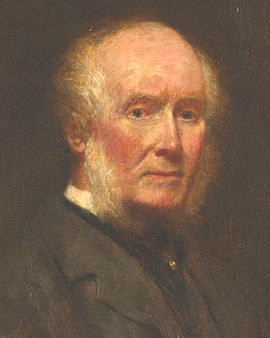Many artists had to assert themselves against their own parents in their youth. Not so William Powell Frith: his talent was recognized and encouraged early on by his own father, a hotelier in North Yorkshire.
In addition to his large, partly monumental landscapes, Frith made a name for himself above all with genre paintings. Victorian Great Britain was marked by the triumphal march of industry, but also by deep social contrasts from great wealth to crushing mass misery.
Frith belonged to the group of painters who were not afraid to capture poverty on canvas. The famous painting "The Crossing Sweeper" shows a ragged little boy preparing to clean the street in front of a well-dressed lady with a broom to get a tip. Two other works by Frith, "The Derby Day" and "Ramsgate Sands", which both depict mass scenes at horse races and on the beach, respectively, do not skimp on the contrast between rich and poor. "The Derby Day" unites one hundred typical figures of all social classes known at that time.
Writers like Charles Dickens lent a voice to poverty - painters like Frith gave it a face. It is no coincidence that many of Frith's paintings have Dickens' novels as their subject. Some of them later served as models for illustrations. That John Powell Frith was elected to the Royal Academy in 1858 illustrates the changing attitudes of his contemporaries: Only a few years earlier, it was unthinkable that paintings of the "scum of society" would have found their way into Britain's highest temple of art.
Another of John Powell Frith's specialities was the production of several pictures on the same subject - often with a gap of several decades. Frith painted "The Crossing Sweeper" three times, the last time in 1890 - the lady always wore current fashion. At that time, after Jack the Rippers' bloodlust had dragged the mass misery in London's East End into the spotlight, the social question was more topical than ever.
Of course, Frith was quite ambivalent: the painter of harmonious family pictures had twelve children by his wife and seven by his mistress - the painter of poverty was at the same time a traditionalist who strictly rejected modern art movements such as Impressionism, the Pre-Raphaelites and the aesthetics of an Oscar Wilde.
×





.jpg)
.jpg)
.jpg)
.jpg)
.jpg)
.jpg)
.jpg)
.jpg)
.jpg)
.jpg)
.jpg)
.jpg)
.jpg)
.jpg)
.jpg)
.jpg)
.jpg)
.jpg)
 and Mary Godwin in Old St Pancras Churchyard 1877 - (MeisterDrucke-193950).jpg)
 and Mary Godwin in Old St Pancras Churchyard 1877 - (MeisterDrucke-193950).jpg)
.jpg)
.jpg)
.jpg)
.jpg)
.jpg)
.jpg)
 Reproving Mary Queen of Scots (1542-87) mid-19th century - (MeisterDrucke-161194).jpg)
 Reproving Mary Queen of Scots (1542-87) mid-19th century - (MeisterDrucke-161194).jpg)
.jpg)
.jpg)
.jpg)
.jpg)
.jpg)
.jpg)
_-_(MeisterDrucke-897569).jpg)
_-_(MeisterDrucke-897569).jpg)
.jpg)
.jpg)
.jpg)
.jpg)
.jpg)
.jpg)
.jpg)
.jpg)
.jpg)
.jpg)
.jpg)
.jpg)
.jpg)
.jpg)
.jpg)
.jpg)
.jpg)
.jpg)
.jpg)
.jpg)
.jpg)
.jpg)
.jpg)
.jpg)
.jpg)
.jpg)
.jpg)
.jpg)
.jpg)
.jpg)
.jpg)
.jpg)
.jpg)
.jpg)
.jpg)
.jpg)
.jpg)
.jpg)
.jpg)
.jpg)
.jpg)
.jpg)
.jpg)
.jpg)
_(see_also_38250)_-_(MeisterDrucke-1019803).jpg)
_(see_also_38250)_-_(MeisterDrucke-1019803).jpg)
.jpg)
.jpg)
.jpg)
.jpg)
.jpg)
.jpg)
.jpg)
.jpg)
_-_(MeisterDrucke-1466485).jpg)
_-_(MeisterDrucke-1466485).jpg)
.jpg)
.jpg)
.jpg)
.jpg)
.jpg)
.jpg)
.jpg)
.jpg)
.jpg)
.jpg)
.jpg)
.jpg)
.jpg)
.jpg)
_-_(MeisterDrucke-1133934).jpg)
_-_(MeisterDrucke-1133934).jpg)
.jpg)
.jpg)
.jpg)
.jpg)
.jpg)
.jpg)
.jpg)
.jpg)
.jpg)
.jpg)
.jpg)
.jpg)
 - (MeisterDrucke-180811).jpg)
 - (MeisterDrucke-180811).jpg)
.jpg)
.jpg)
.jpg)
.jpg)
.jpg)
.jpg)
.jpg)
.jpg)
.jpg)
.jpg)
.jpg)
.jpg)
_-_(MeisterDrucke-1131634).jpg)
_-_(MeisterDrucke-1131634).jpg)
_-_(MeisterDrucke-907511).jpg)
_-_(MeisterDrucke-907511).jpg)
.jpg)
.jpg)
.jpg)
.jpg)
.jpg)
.jpg)
.jpg)
.jpg)
.jpg)
.jpg)
.jpg)
.jpg)
.jpg)
.jpg)
.jpg)
.jpg)
_-_(MeisterDrucke-1466454).jpg)
_-_(MeisterDrucke-1466454).jpg)
.jpg)
.jpg)
.jpg)
.jpg)
.jpg)
.jpg)
.jpg)
.jpg)
.jpg)
.jpg)
.jpg)
.jpg)
.jpg)
.jpg)
.jpg)
.jpg)
 - (MeisterDrucke-243058).jpg)
 - (MeisterDrucke-243058).jpg)
 - (MeisterDrucke-59461).jpg)
 - (MeisterDrucke-59461).jpg)
.jpg)
.jpg)
.jpg)
.jpg)
.jpg)
.jpg)
.jpg)
.jpg)
.jpg)
.jpg)
.jpg)
.jpg)
.jpg)
.jpg)
.jpg)
.jpg)
.jpg)
.jpg)
.jpg)
.jpg)
.jpg)
.jpg)
.jpg)
.jpg)






